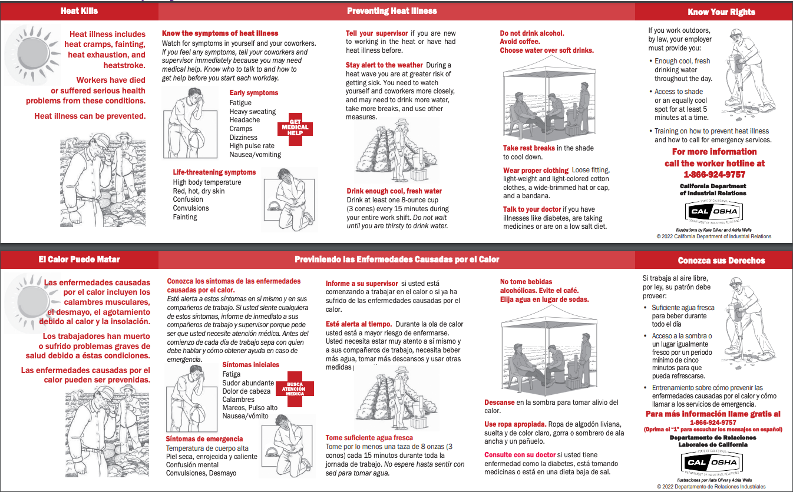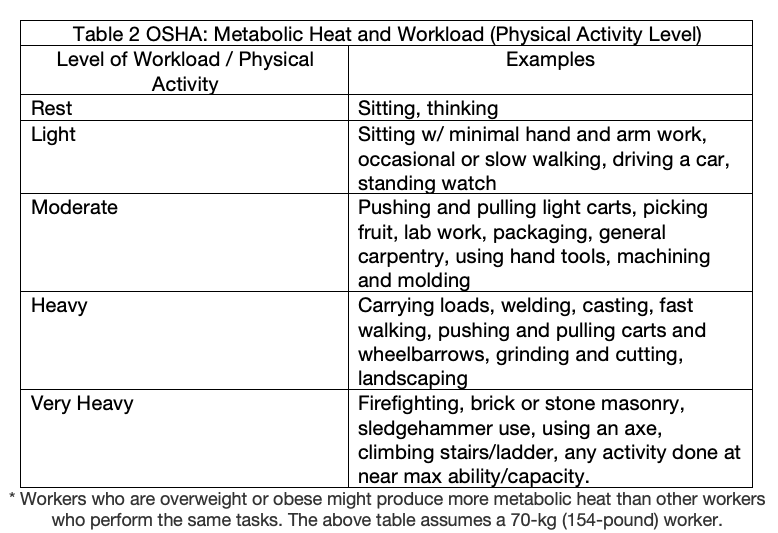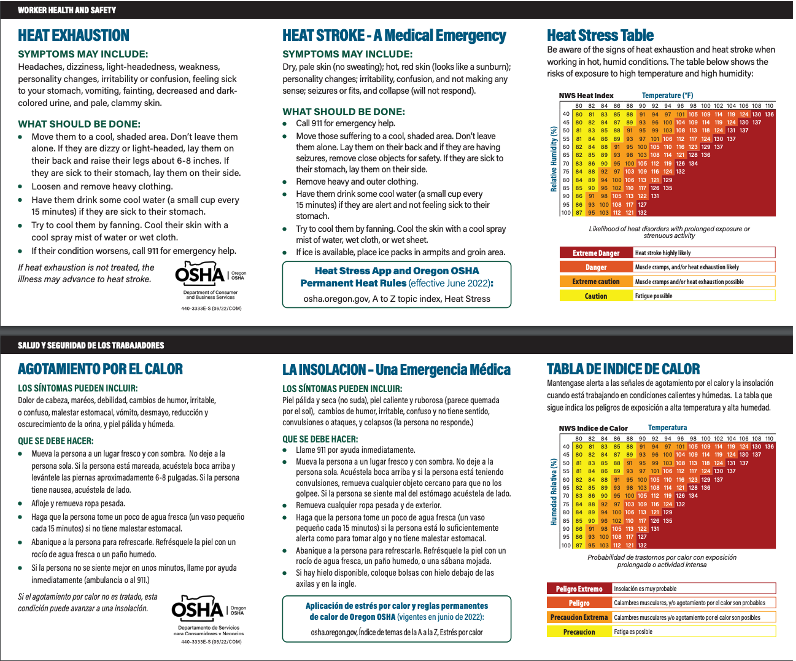California Heat Stress Rules (Maria Isabel Vasquez Jimenez heat illness standard):
The California Heat Illness Prevention regulation was designed to protect outdoor workers from heat illness. It requires employers to take four crucial steps to prevent heat illness by
- providing training to all employees and supervisors about heat illness prevention and actionable steps to take,
- providing enough fresh water for employees to drink a quart every hour, and encouraging them to do so,
- providing shade and encouraging employees to not wait until they feel sick to cool down, and
- establishing a written plan for responding to heat illness in the workplace.
Additionally, all actions are based on an outdoor air temperature of 80 degrees Fahrenheit unless otherwise specified.
Access to Water:
- Water should be placed as reasonably close to where employees are working to maximize accessibility.
- The water must be sufficiently cool and enough water must be available for each worker to consume a quart of water per hour.
Shade:
- Shade has to be present, whether it is natural shade or shade established by an employer (e.g. a tent) when the temperature exceeds 80 degrees Fahrenheit. The shade has to be suitable enough to accommodate the number of workers on recovery or rest periods and they must be able to sit in a normal posture in the uncrowded shade
- Workers should not have to cross hazardous obstacles or navigate any blockades to access shade (e.g. crossing a dangerous road, ditch, or trench without proper precautions)
- Employees will be allowed and encouraged to take preventative cool-down rests in the shade as needed to protect themselves from heat stress symptoms. A worker will be monitored for symptoms, will be encouraged to stay in the shade as long as needed, and shall not be ordered to work until signs or symptoms of heat illness have stopped, but in no less than 5 minutes in addition to the time needed to access the shade.
High Heat Protections: When the temperature equals or exceeds 95 degrees Fahrenheit, these requirements become active:
- Have meetings, before work starts, to review high heat procedures and guidance, and employee rights regarding cool-down/rest breaks.
- Maintain effective communication by voice, observation, or electronic means so employees at the worksite can contact a supervisor when necessary.
- Continuously monitor employees for signs of heat illness. Employers can implement a mandatory buddy system, or regularly communicate with a single employee by radio or cell phone, or have a supervisor or assigned observer of 20 or fewer employees monitor for heat stress symptoms.
- For Agricultural workers: the employer will make sure that employees take a minimum 10-minute cool-down break every two hours. If the work day is longer than 10 hours, an additional break is provided for every 2-hour increment.
Employee Training: Employees will be trained properly on identifying environmental and personal risk factors for heat illness, how to decrease the burden of heat, the employer’s procedures for complying with the Cal/OSHA requirements, emergency plans, and employee's rights.
Supervisor Trainings: Supervisors will be required to know all requirements for employee trainings. In addition, supervisors are to be trained on how to monitor weather reports, and how to respond to hot weather advisories and when an employee shows signs or reports symptoms of heat illness.
Where the CA rule falls short:
- The heat standard shouldn’t be based solely on temperature but either on a heat index or the WBGT as detailed by the American Conference of Governmental Industrial Hygienists (ACGIH) Heat Stress recommendations. This professional association is a group of occupational health professionals and industrial hygienists who create tools and resources to aid these professionals in protecting workers.
- The Oregon set of rules are more specific in some ways. For example, drinking water “must be cool (66 to 77 degrees Fahrenheit) or cold (35 to 65 degrees Fahrenheit.
Heat Illness Employee Card - Cal/OSHA

CA State Resources:
- File a complaint w/ Cal/OSHA
- Full Regulatory Heat Illness Prevention Requirements
Oregon Heat Rules:
Key Requirements and Exemptions:
- The Oregon heat stress rules are triggered when a worksite has a heat index of 80 degrees Fahrenheit or greater.
- Exemptions:
- These workplace conditions are fully exempt from the heat standard: Incidental heat exposures, exposures to heat generated from the work process (e.g. working next to a boiler), emergency operations, and indoor work areas that have a ventilation system that keeps the heat index below 80 degrees Fahrenheit.
- These workplace conditions are partially exempt from the rules but less clarity is provided): Workplaces where “rest” or “light” workloads are most common, associated support activities for wildland firefighters, and employees who work from home.
- Acclimatization: Employers are required to develop effective acclimatization work practices to allow workers to adapt to working at sites where the air temperature exceed a heat index of 80 degrees Fahrenheit.
- Drinking water: Other rules require water to be provided at all times, but the specific requirements for these rules are described below.
- Enough drinking water must be available so that each employee can consume 32 ounces per hour.
- Drinking water must be cool (66 to 77 degrees Fahrenheit) or cold (35 to 65 degrees Fahrenheit).
- Drinking water packaged as a consumer product and electrolyte-replenishing drinks that do not contain caffeine – sports drinks, for example – are acceptable substitutes, but should not completely replace the required water.
*Those performing “rest” or light” work (see below for federal definition), as defined by the rules, are exempt from the specific quantities of water when the heat index is less than 90 degrees Fahrenheit - but still required in other Oregon OSHA provisions.

- Emergency Medical Plan: An employer must develop an emergency medical plan that explains how an employer and responsible supervisors will respond to an employee reporting signs or symptoms of heat illness.
- If an employee reports symptoms of heat illness, the employee must be relieved from duty and receive assistance or resources to help cool off.
- If the signs or symptoms indicate severe heat illness (See Oregon Heat Stress Card), immediately implement the emergency response procedures.
- Supervisor and Employee training: All employers are required to train employees, in a language they can fully understand, in the following topics before they begin work at sites where the heat index is 80 degrees Fahrenheit or more:
- How to identify and adapt/address environmental and personal risk factors for heat illness, including the added burden of heat caused by working, clothing, and PPE, and non work-related factors such as medication use.
- The requirements of the standard (e.g. shade and water requirements)
- The effects of non job factors such as medications
*Those performing “rest” or light” work, as defined by the rules, are exempt from the training requirements when the heat index is less than 90 degrees Fahrenheit.
- Access to Shade:
- Employers are required to provide one or more shade areas when the heat index equals or exceeds 80 degrees Fahrenheit.
- Shade can be provided by natural (e.g. tree-cover) or artificial (e.g. a tent or awning) that is safe and healthy for workers to use.
- Shade must be open to the air or have mechanical ventilation (e.g. Air conditioning), be as close as practical to where employees are working, and accommodate the number of employees on recovery/rest periods.
- When shade cannot be reasonably or safely accessed by employees, like during high winds, the employer must provide cooling measures that provide equivalent protection to shade.
- Employers are required to provide one or more shade areas when the heat index equals or exceeds 80 degrees Fahrenheit.
- High Heat Practices: When the heat index exceeds 90 degrees Fahrenheit, the following additional high heat practices must be implemented:
- Ensure that effective communication is maintained so employees working onsite can contact a supervisor when necessary.
- Ensure that employees are monitored for symptoms of heat illness and be able to call for medical attention when necessary; consider using one of the examples below:
- Regular communication with employees working alone – by radio, cellphone, or other means
- A mandatory buddy system
- Assign one or more employees at each site to call for emergency medical services and allow other employees to call for emergency services when designated employees are not immediately available.
- Ensure that each employee takes heat illness prevention rest breaks
- The rest break can take place with any other meal or rest period required by policy, rule, or law if the timing of the break aligns with the required meal or rest period.
- The preventive cool-down rest break is a work assignment.
Oregon also has rules set for wildfire smoke which was adopted July 1, 2022. If you would like to learn more about this heat-related hazard, visit the Oregon OSHA page here.
For more information on the progress of these Oregon-based rules, visit Oregon OSHA here. And to access all of Oregon OSHA’s resources, please visit here.
Oregon OSHA Heat Stress Card

Oregon State Resources:
Heat Illness Prevention Requirements
Online Heat Illness Prevention Course
Supportive Assistance to Individuals and Families Program (SAIF) – Heat Stress
Washington Heat Stress Standard
Washington currently has a weaker heat exposure rule than Oregon and California, However, in March of this year, the Department of Labor & Industries (L&I) filed updates for the Outdoor Heat Exposures rules. The proposed updates address minimum requirements to prevent heat-related illness and reduce injuries for outdoor workers, but these changes do not address any indoor workers.
The Washington standard requires:
- Outdoor heat exposure safety is addressed as part of the required Accident Prevention Program
- Annual training be provided to employees and supervisors on recognizing and responding to symptoms of outdoor heat exposure and the policies in place to prevent heat-related illness
- Workers should use systems (e.g. the buddy system) and communication practices to make sure they and their co-workers are safe and not showing symptoms of heat related illness. These practices must be supported by their employers and supervisors.
- Water to be provided to workers according to the Federal OSHA guidance (1 quart of safe drinking water per employee, per hour) and at a temperature that is cooling for workers
The Washington standard appears to be a meaningful start to addressing heat-related injuries in the workplace, but there are some key weaknesses in the standard that should be addressed in future updates to the outdoor heat standard. Below are a few examples:
Weaknesses of the Standard
- Washington state’s heat protections apply only during May – September, and only when employees are exposed to outdoor heat at or above the temperatures listed below in table 3.
- Because these action levels rely on temperatures and not a heat index, environmental factors such as humidity, the amount of direct sunlight, and wind are not accounted for.
- The table doesn’t account for, or provide clear guidance on how workers could wear a mixture of these clothing items and personal protective equipment (PPE), and how employers should assess them.
- There is no requirement to maintain temperature records for employers.
- There is no specific guidance on how shade should be created for workers. As a result, workers could be forced to seek shade in less safe areas until an inspection is requested or filed by a complaint.

Washington State Resources
Outdoor Heat APP Addendum – English & Spanish
Bilingual Pocket Card on Heat-related Illnesses and Prevention
Minnesota - Indoor Heat Ventilation and Temperature Standard
Minnesota has one of the only standards intended to protect indoor workers from heat-related illnesses. The requirements state that workers cannot be exposed to indoor environmental heat conditions exceeding the values listed in table 4. The limits are based off of a WBGT and how strenuous or heavy a workload is for a worker over a two-hour time-weighted average (i.e. an average of WBGT over a 2-hour time period).

Minnesota also bases their definition on heavy work on the number of calories burned per hour. Most of federal OSHA’s recommendations are based on a 154-pound worker, and generally, the calories per hour are aligned closely with the Federal recommendations. This has several key weaknesses but most apparent is that workers burn calories at different rates based on weight, sex and gender, level of fitness, cardiac health, and a number of other health-related factors such as pre-existing conditions (e.g. diabetes or asthma). The standard also requires that workers be trained as required by federal OSHA’s Hazard Communication rule as Heat is considered a hazard in the workplace (for more information on this rule, see our Chemicals sections).
As a result, this standard is not comprehensive, but it does provide the state, and others, with a framework to build off of. For example, Minnesota’s rule requires that outdoor air be provided to all indoor workplaces at a rate of 15 cubic feet per minute, per person while maintaining that air cannot exceed 200 feet per minute so workers are not subjected to high levels of noise and possibly causing harm by debris, dust, and other potential hazards.
Minnesota State Resources:
Minnesota Heat Stress Guidance + Rule
Minnesota Safety Council – Heat Safety 101
Minnesota Public Health Data Access – Heat Related Illness


